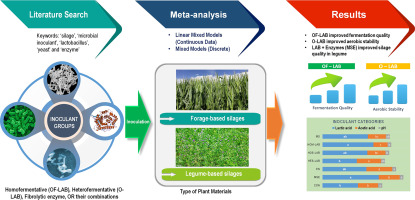Influence of Additive Treatment on Silage Quality
Neelam Kumari and Gourav Biswas
Silage is gaining popularity in different regions of India as it provides a constant supply of roughage throughout the year. The basis of ensiling is the naturally occurring anaerobic fermentation of fodder in the presence of lactic acid-producing bacteria, which convert readily fermentable carbohydrates into organic acids, primarily lactic acid. Ensiling is inherently an uncontrolled process that depends on the epiphytic microflora.
Silage fermentation processes
The ensiling process is divided into four principal phases (Phalow et al., 2003).
Phases of fermentation
| S. No | Phase | Duration | Comments |
| 1. | Aerobic phase | 2 days | This phase is characterized by crop respiration and activity of all obligate and facultative aerobic organisms such as molds, yeasts and some bacteria until they finish up all the oxygen. |
| 2. | Fermentation phase | 2-14 days | Anaerobic conditions start and lactic acid bacteria dominant and begin the fermentation process, which results in pH reduction (due to lactic acid production). |
| 3. | Stable Storage | As long as air can be prevented | Large bacterial populations can use lactic acid and produce butyric acid rather than lactic acid by secondary fermentation |
| 4. | Feed out phase | Starts as soon
as silage exposed to air |
As the silo is opened, silage comes in contact with oxygen and molds, yeasts and acetic acid bacteria consume the acids, sugars and protein for growth releasing heat and can cause considerable changes in the chemical composition. The pH of silage starts rising and other microorganisms that were inhibited can proliferate resulting in massive spoilage. |
Silage additive
Additives are either natural or chemical compounds that are added in small quantities to the forage or grain mass and may provide additional benefits. The objective of adding an additive is to improve the nutrient composition of silage, reduce storage losses by promoting rapid fermentation and improve silage bulk life (increase aerobic stability) (Merensalmi and Virkki, 1991).
Silage additives can control the course of the ensiling process and improve fermentation quality and aerobic stability. Based on an analysis of various silage experiments, homofermentative lactic acid bacteria increased dry matter recovery (DMR) during the fermentation of fodder and increased the efficiency of the ensiling process.
It has been observed that silage high in carbohydrates or well-preserved silages with high lactic acid concentrations and low quantities of volatile fatty acids (acetic acid) are particularly susceptible to aerobic degradation. The main cause of the aerobic deterioration of silage is the growth of yeasts and moulds, which remain latent in anaerobic conditions and quickly multiply when exposed to air. Obligatory heterofermentative lactic acid bacteria have proven to improve silage aerobic stability by producing acetic acid. The fermentation of undesirable bacteria is frequently inhibited by chemical additives (propionic acid), which decreases losses and stops the growth of yeasts.
Type of silage additive
| S. No | Type of Additive | Selection of active ingredients | Remarks |
| 1. | Fermentation stimulants | Molasses (sugars),
enzymes and lactic acid bacteria (LAB) |
May impair aerobic stability |
| 2. | Fermentation inhibitors | Formic acid, acetic acid, lactic acid, propionic acid, mineral acid formaldehyde, sodium nitrite, sodium metabisulphite | Inhibits the growth of undesirable microbes |
| 3. | Aerobic spoilage inhibitors | Propionic acid
benzoic acid and sorbic acid some inoculants |
Improve aerobic stability |
| 4. | Nutrients | Urea, ammonia, grain, minerals, sugar beet pulp | Improve the nutritive value of silage |
| 5. | Absorbents | Grain, straw, bentonite, sugar beet pulp, polyacrylamide | Improve crop preservation and its feeding value |
References
Koc, F., Coskuntuna, L. and Ozduven, L. (2008). The effect of bacteria+ enzyme mixture silage inoculant on the fermentation characteristic, cell wall contents and aerobic stabilities of maize silage. Pakistan Journal of Animal Science, 7, 222-226.
Merensalmi, M. and Virkki, M. (1991, January). The role of enzymes in the preservation and utilization of forage. In Forage Preservation. Proceedings of 5th International Symposium, Nitra, Slovakia, 43-46.
Pahlow, G., Muck, R. E., Driehuis, F., Elferink, S. J. O. and Spoelstra, S. F. (2003). Microbiology of ensiling. Silage Science and Technology, 42, 31-93.


